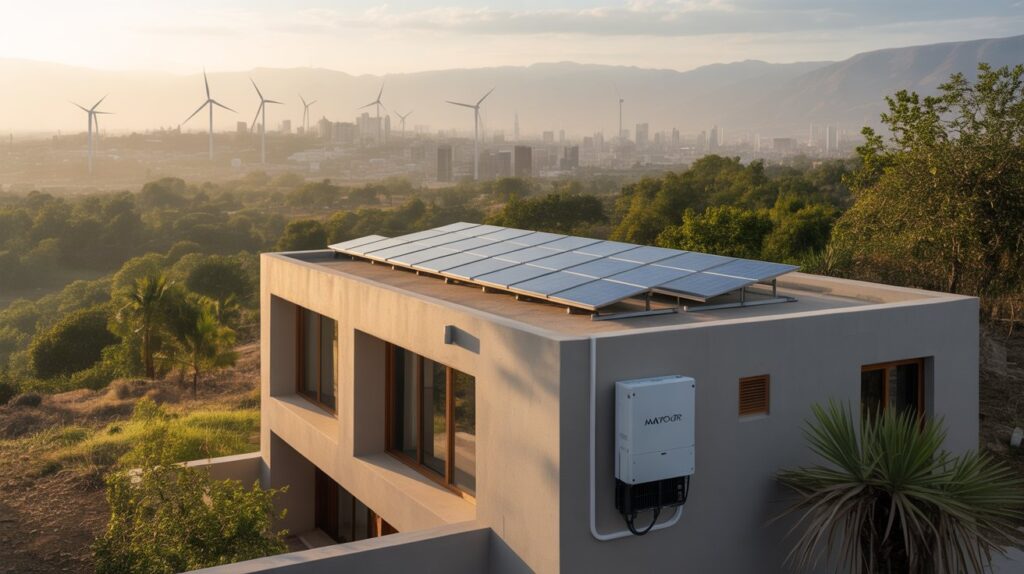The Rising Future of Solar Energy: Opportunities and Adoption in Pakistan and Beyond
Around the world, the renewable energy sector is gaining momentum, and solar energy is at the forefront of this transformation. In 2025, solar power is no longer just an alternative—it’s becoming a necessity in regions battling rising energy costs, fuel shortages, and climate challenges.

For countries like Pakistan, where energy crises remain a recurring issue, the adoption of solar energy is accelerating rapidly. Falling solar prices in Pakistan, better financing options, and improved awareness are making solar solutions more accessible than ever.
This post explores the benefits of solar power, global and local adoption trends, challenges, and why investing in solar today can create a sustainable future for generations to come.
Why Solar Energy Matters in 2025
Global Growth and Statistics
According to the International Energy Agency (IEA), solar accounted for nearly two-thirds of global renewable capacity additions in 2024.
- Solar PV installations are projected to surpass 500 GW worldwide by the end of 2025, making it the fastest-growing renewable source.
- Solar costs have declined by over 80% since 2010, making it more affordable than coal or gas in many regions.
- By 2030, solar energy could supply up to 25% of global electricity needs if current growth continues.
The Pakistani Perspective
In Pakistan, frequent load shedding, rising oil imports, and volatile electricity tariffs are pushing households and businesses toward solar adoption. According to the Alternative Energy Development Board (AEDB), Pakistan added more than 2 GW of solar capacity by mid-2024, with further growth expected as policies and subsidies expand.
Key Benefits of Solar Energy
Energy Independence
Solar systems help households and businesses reduce dependency on the national grid. With hybrid inverters and battery storage, users can ensure backup during outages.
Cost Savings
Although the initial investment may seem high, solar panel systems pay for themselves within 3–5 years through reduced electricity bills. With competitive solar panel price in Pakistan, the payback period is getting shorter.
Environmental Benefits
Every 1 kW of solar installed reduces 1.5 tons of CO2 annually. For Pakistan, a country vulnerable to climate change, this is a crucial step toward sustainability.
Job Creation
The solar sector is expected to generate thousands of new jobs across Pakistan, from manufacturing to installation and maintenance.
Solar Adoption Trends in Pakistan
- Increasing Demand for Residential Solar
With net metering policies introduced by NEPRA, homeowners can now sell excess solar energy back to the grid. This has encouraged families in urban areas like Lahore, Karachi, and Islamabad to shift to solar rooftops. - Commercial and Industrial Growth
Industries in Pakistan face high operational costs due to expensive electricity. To remain competitive, many textile mills, cement factories, and shopping centers are investing in large-scale solar plants. - Rural Electrification
In remote areas with little or no grid access, solar solutions are providing off-grid energy independence. Projects funded by NGOs and government programs are helping villages gain electricity for the first time.
Challenges in Solar Adoption
While solar adoption is growing, certain challenges still exist:
- High upfront costs despite long-term benefits.
- Lack of awareness about financing options like solar leasing or installment plans.
- Inconsistent policy support and bureaucratic delays.
- Quality issues due to substandard imports in the market.
However, reputable suppliers, strong policies, and increased competition are gradually solving these issues.
Practical Insights for Solar Investors and Homeowners
Choosing the Right Solar Panels
Not all solar panels are equal. Monocrystalline panels are more efficient but costly, while polycrystalline panels are affordable but slightly less efficient. The choice depends on budget and available roof space.
Importance of Inverters
Inverters are the heart of any solar system. Hybrid inverters with battery support are ideal for Pakistan, ensuring continuous power during load shedding and making solar truly reliable.
Choosing the right inverter also depends on the type and capacity of battery you plan to use, since storage is becoming a key part of every solar setup. With falling battery prices in Pakistan, more homeowners are opting for inverter + battery combinations that balance efficiency, cost, and long-term savings.
Financing Options
Banks in Pakistan are increasingly offering green financing loans, making solar more accessible. For example, the State Bank of Pakistan’s renewable energy scheme offers financing at subsidized rates.
Real-World Example: A Textile Industry Case Study
A leading textile group in Faisalabad installed a 10 MW solar plant in 2024. The company reduced its annual energy costs by 30%, saving millions while also cutting its carbon footprint. This example highlights how industries can benefit from solar adoption while maintaining global competitiveness.
Global Inspiration: Learning from Other Countries
- India: Added over 20 GW of solar capacity in 2024, supported by subsidies and solar parks.
- China: Remains the global leader in solar manufacturing, contributing over 70% of the world’s panels.
- Middle East: UAE and Saudi Arabia are investing billions into mega solar projects, targeting 50% renewable energy by 2030.
Pakistan can replicate such models by introducing consistent policy frameworks, reducing import duties on high-quality panels, and encouraging local manufacturing.
Future of Solar in Pakistan
By 2030, Pakistan aims to generate 60% of its electricity from clean energy sources, with solar playing a central role. With the declining solar panel price in Pakistan, wider financing options, and greater awareness, the country is well-positioned to become a regional leader in renewable energy.
Conclusion & Call to Action
Solar energy is not just about reducing bills—it’s about securing a sustainable and independent energy future. Pakistan, with its abundant sunshine, has the potential to lead South Asia in renewable adoption if stakeholders work together to remove barriers.
Whether you’re a homeowner, business owner, or policymaker, now is the best time to invest in solar. Start by evaluating your energy needs, comparing options, and consulting reliable providers.
�� Explore the latest solutions and compare inverter options at Solar Panel Price in Pakistan — your trusted guide to a brighter, cleaner, and more affordable energy future.
